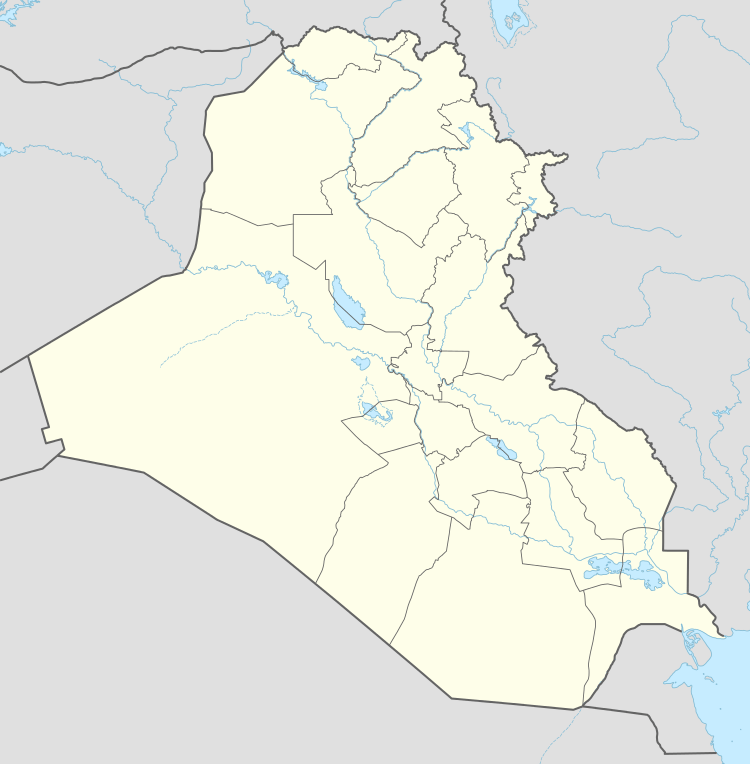Sawa lake
| Sawa Lake | |
|---|---|
 | |
| Location | Muthanna Governorate, Iraq |
| Coordinates | 31°18′46.3″N 44°57′36.6″E / 31.312861°N 44.960167°ECoordinates: 31°18′46.3″N 44°57′36.6″E / 31.312861°N 44.960167°E |
| Lake type | Endorheic basin |
| Max. length | 4.74 km (2.95 mi) |
| Max. width | 1.77 km (1.10 mi) |
| Surface area | 12.5 km2 (4.8 sq mi) |

Sawa lake (Arabic: بحيرة ساوة) is an Endorheic basin located in the Iraqi governorate of Muthanna near to the Euphrates River, some 23 kilometres (14 mi) to the west of Al-Samawa city. This lake has no inlet or outlet but,its feeds water from Euphrates through a system of joint cracks and fissures which transport water to aquifers beneath it. water's level fluctuates during dry and wet seasons. Water does not dry up because of the equilibrium state between water feed and evaporation.
Description
Lake Sawa is a unique body of water in Iraq since characterized by highest salinity value among Iraqi inland bodies water. The lake has longitudinal shape with 4.47 km, long and 1.77 km wide.The water level in the lake is one of the manifestations of the lake, which gives something of aesthetic and strangeness. Strangeness reflected the fact that the water level in the lake is higher than the adjacent land around the lake by 1–4 meters . Add to that, the water level of the lake is also higher than the water level of the Euphrates River by 5–7 meters which flow near the lake to the east side and the Shat Al-Arab and Persian Gulf by 17–20 m.[1] A formations of gypsum are surrounding the lake, in some cases these a gypsum formations reach 6 m tall. They are formed due to evaporation of salty water and sedimentation of salt in shallow banks of lake.[2] A formations of gypsum works as a dam prevent water flow from the lake on surrounding areas.
Climate
Sawa lake is characterized by arid climate. Highest and lowest temperatures are ranges between (27.6– 44.6) °C. Mean annual rainfall is 110 mm per year, highest values of evaporation occur during July (506 mm) while lowest values occurring in January (89 mm). Overall wind direction is a North-West with speed of 4.1 m/s. [3]
Flora and fauna
Because of its saline water, no plants grow in the lake or on its shores. Fish and algae are the most important aquatic organisms. One kind of fish lives in Sawa lake, the Arabian toothcarp of the genus Aphanius, Cyprinodontidatae family, characterized by its soft appearance, small size (they do not exceed 10 cm), and eyes that quickly disappear after death. Also there are Pomatiopsis tryon which is Gastropoda genus and lives in brackish water from Oligocene age to recent times, particularly on the lake bottom.
Unlike scarce aquatic organisms, Sawa lake rich with birds,25 spices of resident and immigrant birds were observed in Sawa Lake and the surrounding areas. the lake held large numbers of waterfowl, mainly ducks and coot (Fulica atra). The endemic race of little grebe (Tachybaptus ruficollis iraquensis) and the Mesopotamian crow (Corvus cornix capellanus) occur, as well as the near-endemic grey hypocolius. Locals and hunters reported the frequent occurrence of “different kinds of raptors” especially in spring and autumn, so the site may be important as a staging area.
The desert area on the western side of the lake, the fresh wetland strip (represented by the western branch of Euphrates River including the orchards), and the flat arid/semi-desert areas over the southern parts of the lake might harbor considerable wildlife diversity, mammals present include Rüppell's fox, striped hyena (near-threatened), honey badger, and Indian gray mongoose (Herpestes edwardsii). Reptiles found included: Water snake (maybe Natrix tessellata).[4]
Environmental Concerns
As Sawa Lake represents a unique, closed water body in Iraq it is an important site to protect for its scientific, educational and biodiversity value. Only human intrusion was considered a high threat because Sawa Lake is the only water body available for the city of Samawa and its surroundings. It is a popular picnic area but this has caused a great deal of garbage accumulation everywhere around the lake. There appears to be no effort by visitors or government to manage or remove garbage from the site. Because there is no plant cover on the lake (reed beds, etc.), water birds have few places to shelter from visitors or hunters. Three threats were classified as ‘high’:urban expansion (the team was informed that the lake area was submitted for an investment project which might involve new construction around the lake); hunting, primarily represented by fishing (mainly netting) and hunting of birds, and pollution caused by the frequent visitors. Other threats (agriculture, resource extraction, transportation & service corridors, and natural systems modification) were considered ‘low’.[4]
References
- ↑ "Bull. Iraq nat. Hist. Mus.".
- ↑ "Iraqi Academic Scientific journal".
- ↑ Iraqi Meteorological Organization., 2012: Climate data of recorded in Al-Sammwa station forperiod from (1990-2011)
- 1 2 "Sawa Lake and the surrounding area (MT1)" (PDF).